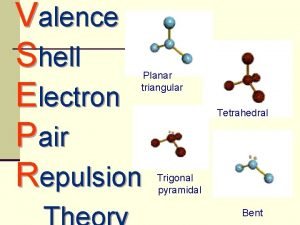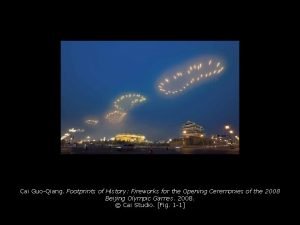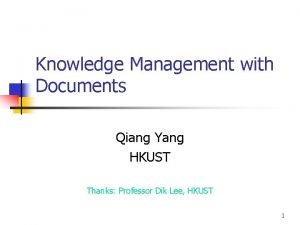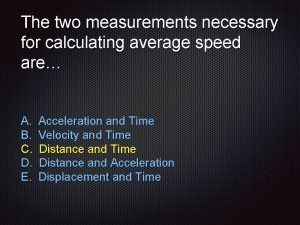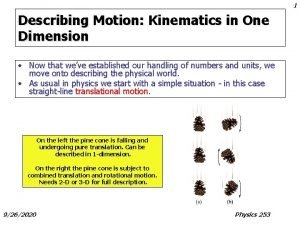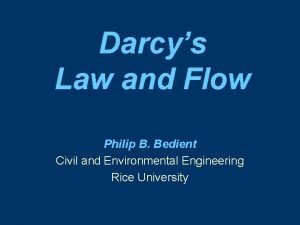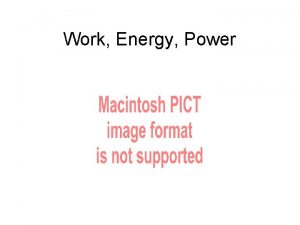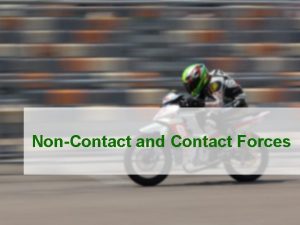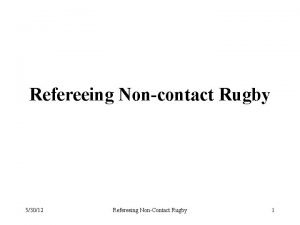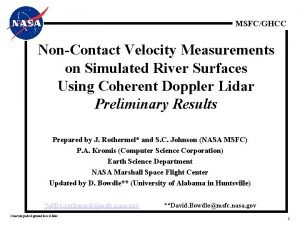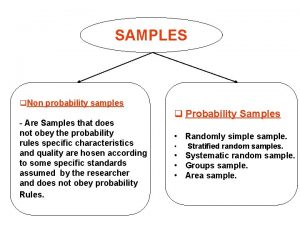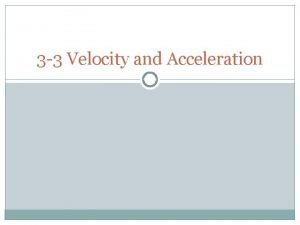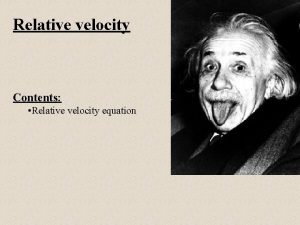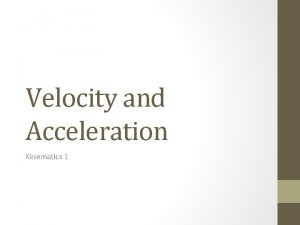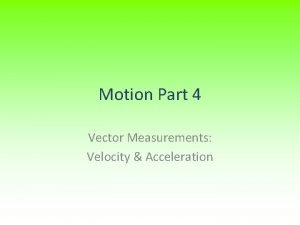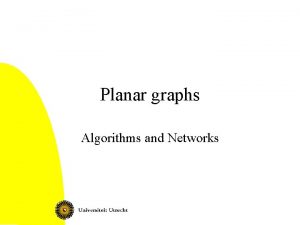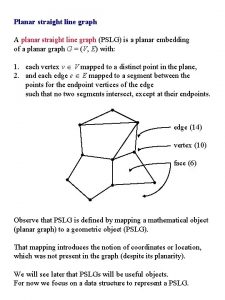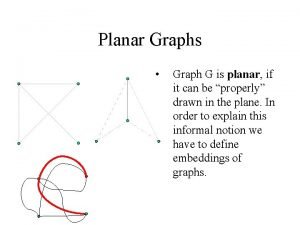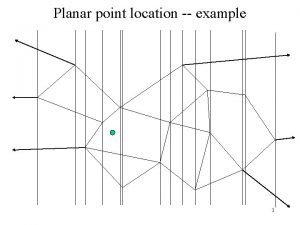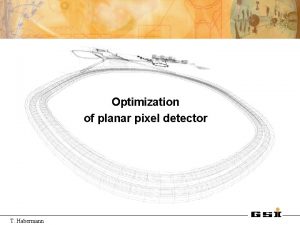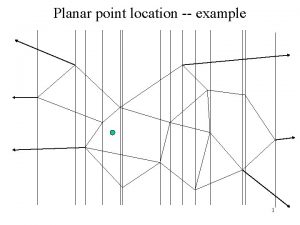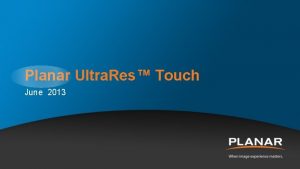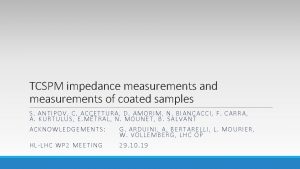Noncontact aircoupled velocity measurements in planar samples Qiang


















- Slides: 18

Non-contact air-coupled velocity measurements in planar samples Qiang LIU 1, 2, Bogdan PIWAKOWSKI 2, Zoubeir LAFHAJ 1 1. Laboratoire de Mécanique de Lille (LML, UMR CNRS 8107), Ecole Centrale de Lille 2. Institut d’Electronique, Microélectronique et Nanotechnologies (IEMN UMR 8520), Ecole Centrale de Lille The 13 th International Symposium on Nondestructive Characterization of Materials

OUTLINE I. Context and goal II. Contact methods III. Non-contact methods IV. Experimental results V. Conclusions 06/12/2020 The 13 th International Symposium on Nondestructive Characterization of Materials 2

Context and goal 1. Necessity to mesure velocity. 2. Traditional methods are contact type. 3. We have developed a non-contact air-coupled system in order to: a) Avoid coupling medium; b) Avoid surface preparation; c) Enable the automation of measurement. Objective: To measure velocities by using non-contact air-coupled technique with good accuracy. 06/12/2020 The 13 th International Symposium on Nondestructive Characterization of Materials 3

Contact methods 1. Pulse-echo: Transmitter/Receiver Need of coupling meduim Need of planar contact surface d 1 st Nth Δt 2. Through-transmission: Δt Δt 1 st Transmitter Nth Receiver d 06/12/2020 The 13 th International Symposium on Nondestructive Characterization of Materials 4

Immersion method Water Receiver Transmitter d 06/12/2020 The 13 th International Symposium on Nondestructive Characterization of Materials 5

Non-contact air-coupled method Air Receiver Transmitter 0. 01% d 06/12/2020 The 13 th International Symposium on Nondestructive Characterization of Materials 6

Two problems: The immersion solutions developed for water cannot be applied directly for air because: • The velocity in air is unstable, so it is better not to use velocity in air for the computation of velocity in sample. • The transmission coefficient is too small to allow the emitted energy penetrate into the sample, so it is necessary to apply techniques which improve the signal level. 06/12/2020 The 13 th International Symposium on Nondestructive Characterization of Materials 7

« Chirp» signal A A Transmitter Receiver A t t T Correlation 06/12/2020 The 13 th International Symposium on Nondestructive Characterization of Materials 8

Experimental setup PC Generator: Generation of chirp; Memory card: Acquisition of signal; Lab. View: Correlation. Power Amplifier Motor control Movements in x, y , z directions; Pre Amplifier Receiver Transmitter z Motor control z y y PC x Amplifier 06/12/2020 Transmitter x Receiver The 13 th International Symposium on Nondestructive Characterization of Materials 9

Calibration Receiver Before calibration Transmitter Beam axis L y After calibration Receiver Transmitter Beam axis L 06/12/2020 y The 13 th International Symposium on Nondestructive Characterization of Materials 10

Receiver Transmitter 2 1 ΔL L 1 L 2 y The moving direction of receiver First step: Calculation of Vair (1) ta 1 06/12/2020 The 13 th International Symposium on Nondestructive Characterization of Materials 11

Receiver d Transmitter The moving direction of receiver Second step: Calculation of VL 1 2 3 y L 1 2 Δtp Δtp (2) (3) tp 1 06/12/2020 The 13 th International Symposium on Nondestructive Characterization of Materials 12

Receiver d Transmitter The moving direction of receiver Second step: Calculation of VL 1 2 3 y L 1 2 Δtp Δtp (2) (3) tp 1 06/12/2020 The 13 th International Symposium on Nondestructive Characterization of Materials 13

Third step : Calculation of VT Receiver Transmitter β α Δy d y αc 1<α<αc 2 The incident angle should greater than the first critical angel and less than the second critical angle. 1 2 Δy (4) Δts (5) ts 1 06/12/2020 ts 2 (6) The 13 th International Symposium on Nondestructive Characterization of Materials 14

Validation with Plexiglas plate Comparing with the velocity obtained by contact method we find: 1. For longitudinal velocity, the ‘Multiple’ approach is more precise than the ‘Direct’ approach, because the velocity in air isn’t used here. As well the standard error of ‘Multiple’ approach is smaller. 2. For shear velocity, the results of ‘Multiple’ and ‘Shift’ approaches are also more precise than the ‘Direct’ approach. 06/12/2020 The 13 th International Symposium on Nondestructive Characterization of Materials 15

Results obtained with porous material : mortar sample Our conclusions are confirmed with a mortal sample. Comparing with contact approach: 1. For longitudinal velocity, our ‘Multiple’ approach produces only 0. 7% error while the ‘Direct’ approach produces 43. 8% error. 2. For shear velocity, our ‘Multiple’ approach provides only 26. 5% error, Shift’ approach provides 2. 3% error white the ‘Direct’ approach produces 38. 3% error. 06/12/2020 The 13 th International Symposium on Nondestructive Characterization of Materials 16

Conclusions 1. ‘Direct’ approach, comes from immersion method, and commonly used in non-contact air-coupled technique gives always a high error when compares it with contact method. 2. ‘Multiple’ approach for longitudinal velocity and ‘Shift’ approach for shear velocity provide higher accuracy which is comparable with the contact method. 3. Non-contact air-coupled method has great potential for the rapid measurements of velocity in ‘difficult’, porous, rough surface materials, such as concrete. 4. The proposed approach can be easily automated and used in high speed automatic NDT systems. 06/12/2020 The 13 th International Symposium on Nondestructive Characterization of Materials 17

Thank you for you attention! 06/12/2020 18
 Trigonal planar vs triangular planar
Trigonal planar vs triangular planar Qiang jiang
Qiang jiang Cai guo qiang footprints of history
Cai guo qiang footprints of history Qiang yang hkust
Qiang yang hkust Qiang yang hkust
Qiang yang hkust Qiang jiang
Qiang jiang A cart travels with a constant nonzero acceleration
A cart travels with a constant nonzero acceleration Linear quantity
Linear quantity Instantaneous velocity vs average velocity
Instantaneous velocity vs average velocity Initial velocity and final velocity formula
Initial velocity and final velocity formula Darcy velocity vs actual velocity
Darcy velocity vs actual velocity Final velocity initial velocity acceleration time
Final velocity initial velocity acceleration time Tangential speed
Tangential speed Tangential speed
Tangential speed Darcy velocity vs seepage velocity
Darcy velocity vs seepage velocity Formula of velocity
Formula of velocity P=fv meaning
P=fv meaning Contact vs field forces
Contact vs field forces Examples of non contact force
Examples of non contact force
